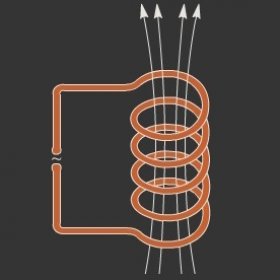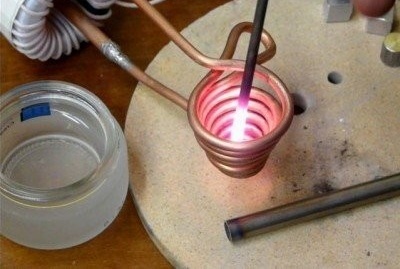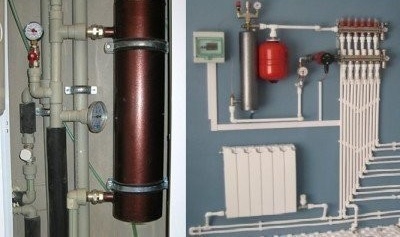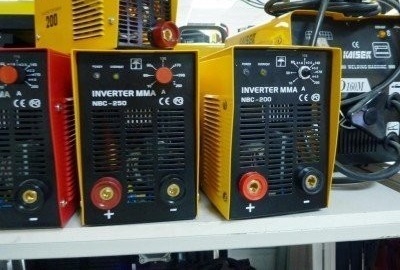Home-made swirl induction heater from a welding inverter

Electric heaters are extremely easy to use. They are much safer than any gas equipment, do not produce soot and soot, unlike units that run on liquid or solid fuel, finally, they do not need to harvest firewood, etc. The main drawback of electric heaters is the high cost of electricity. In search of savings, some craftsmen decided to make an induction heater with their own hands. They received excellent equipment, which requires much less work.
The principle of operation of induction heating
The induction heater uses electromagnetic field energy, which the heated object absorbs and converts into heat. An inductor, i.e. a multi-turn cylindrical coil, is used to generate a magnetic field. Passing through this inductor, an alternating electric current creates an alternating magnetic field around the coil.

A homemade inverter heater allows you to heat quickly and to very high temperatures. With the help of such devices it is possible not only to heat water, but even to melt various metals
If a heated object is placed inside or near the inductor, it will be pierced by the flux of the magnetic induction vector, which constantly changes over time. In this case, an electric field arises, the lines of which are perpendicular to the direction of the magnetic flux and move in a closed circle. Thanks to these vortex flows, electrical energy is transformed into heat and the object is heated.
Thus, the electric energy of the inductor is transmitted to the object without the use of contacts, as is the case in resistance furnaces. As a result, thermal energy is consumed more efficiently, and the heating rate increases markedly. This principle is widely applied in the field of metal processing: its melting, forging, brazing, etc. With no less success, a vortex induction heater can be used to heat water.
Induction heat generator in the heating system
To organize the heating of a private house using an induction heater, it is easiest to use a transformer, which consists of a primary and secondary short-circuited winding. Eddy currents in such a device occur in the internal component and direct the resulting electromagnetic field to the secondary circuit, which simultaneously acts as a housing and a heating element for the coolant.
Please note that not only water, but also antifreeze, oil and any other conductive media can act as a heat transfer medium during induction heating. In this case, the degree of purification of the coolant does not matter much.

The inverter heater has a compact size, operates silently and can be installed in almost any suitable place that meets safety requirements
Induction heating boiler equipped with two nozzles. The lower pipe, through which the coolant will flow, must be installed on the inlet section of the pipeline, and a pipe is installed at the top that transfers the hot coolant to the supply section of the pipeline. When the coolant in the boiler heats up, a hydrostatic pressure occurs, and coolant enters the heating network.
There are a number of advantages to using an induction heater, which should be mentioned:
- the coolant in the system is constantly circulating, which prevents the likelihood of overheating;
- the induction system vibrates, as a result, scale and other precipitation do not deposit on the walls of the equipment;
- the absence of traditional heating elements allows the boiler to be operated with high intensity without fear of frequent breakdowns;
- the absence of detachable connections eliminates leaks;
- the operation of the induction boiler is not accompanied by noise, so it can be installed in almost any suitable room;
- induction heating does not release any hazardous fuel decomposition products.
Safety, silent operation, the ability to use a suitable coolant and equipment durability have attracted many homeowners. Some of them are thinking about the possibility of making a home-made induction heater.
How to make an induction heater yourself?
The independent manufacture of such a heater is not a very difficult task, which even a novice master can handle. First you need to stock up:
- a piece of plastic pipe with thick walls, which will become the body of the heater;
- steel wire with a diameter of not more than 7 mm;
- adapters for connecting the heater body to the heating system of the house;
- a metal mesh that will hold pieces of steel wire inside the case;
- copper wire to create an induction coil;
- high frequency inverter.
To begin with, you should prepare a steel wire. To do this, it is simply cut into pieces about 5 cm long. The bottom of a piece of plastic pipe is closed with a metal mesh, pieces of wire are poured inside, and the top is also covered with a metal mesh. The housing must be completely filled with pieces of wire. In this case, not only stainless steel wire may be acceptable, but also from other metals.
Then you should make an induction coil. As a basis, a prepared plastic case is used, on which 90 turns of copper wire are carefully wound.
After the coil is ready, the housing with the help of adapters is connected to the heating system of the house. After that, the coil is connected to the network through a high-frequency inverter. It is considered quite advisable to make an induction heater from a welding inverter, since this is the simplest and most inexpensive option.

Most often, in the manufacture of home-made vortex induction heaters, inexpensive models of welding inverters are used, since they are convenient and fully meet the requirements
It should be noted that you should not test the device if the coolant is not supplied to it, otherwise the plastic case can melt very quickly.
An interesting version of an induction heater made of a hob is presented in the video material:
A few helpful safety tips
To increase the safety of the structure, it is advisable to insulate open sections of the copper coil.
Induction heater is recommended only for closed heating systems, in which forced circulation of the coolant by means of a pump is carried out.
The induction heating system should be placed at least 30 cm from walls and furniture and at least 80 cm from the ceiling or floor.
To make the operation of the device safer, it is recommended to equip it with a manometer, as well as an automatic control system and devices for removing air that has entered the system.



6 comments